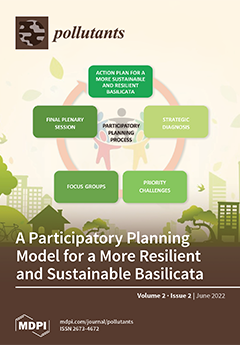Electronic air cleaning (EAC) technologies have garnered significant attention for use in buildings. Many EAC technologies rely on the addition of reactive constituents to indoor air to react with gas-phase compounds, enhance particle deposition, and/or inactivate microorganisms. However, limited data are available on
[...] Read more.
Electronic air cleaning (EAC) technologies have garnered significant attention for use in buildings. Many EAC technologies rely on the addition of reactive constituents to indoor air to react with gas-phase compounds, enhance particle deposition, and/or inactivate microorganisms. However, limited data are available on the efficacy of many EAC technologies and their potential to form chemical byproducts during operation. Here we experimentally evaluate the indoor air quality impacts, specifically targeting particles and gases but not microbial constituents, of a commercially available additive oxidizing EAC that generates positive and negative ions and hydrogen peroxide (H
2O
2). Tests were conducted in a large unoccupied test chamber in Chicago, IL and an unoccupied laboratory in Portland, OR under a combination of natural conditions (i.e., without pollutant injection) and perturbation conditions (i.e., with pollutant injection and decay). A combination of integrated and time-resolved measurements was used across both test locations. Chamber tests at lower airflow rates demonstrated that operation of the EAC: (i) had no discernible impact on particle concentrations or particle loss rates, with estimated clean air delivery rates (CADRs) for various particle measures less than ±10 m
3/h, (ii) was associated with apparent decreases in some volatile organic compounds (VOCs) and increases in other VOCs and aldehydes, especially acetaldehyde, although a combination of high propagated uncertainty, limitations in test methods (e.g., lack of replicates), and variability between repeated tests limit what quantitative conclusions can be drawn regarding gas-phase organics; (iii) did generate H
2O
2, assessed using a crude measure, and (iv) did not generate ozone (O
3). Laboratory tests at higher airflow rates, which involved injection and decay of particles and a single VOC (limonene), both simultaneously and separately, demonstrated that: (i) pollutant loss rates for both particles and limonene were slightly lower with the EAC on compared to off, yielding slightly negative pollutant removal efficiencies (albeit largely within propagated uncertainty) and (ii) there was a change in observed concentrations of one potential limonene degradation product,
m/
z 59 (putatively identified as acetone), with steady-state levels increasing from 10 ppb (air cleaner off) to 15 ppb (air cleaner on). No increases or decreases beyond measurement uncertainty were observed for other analyzed gaseous limonene degradation products. Overall, both chamber and laboratory tests demonstrated negligible effectiveness of this device at the test conditions described herein for removing particles and mixed results for VOCs, including decreases in some VOCs, no discernible differences in other VOCs, and apparent increases in other compounds, especially lower molecular weight aldehydes including acetaldehyde.
Full article



